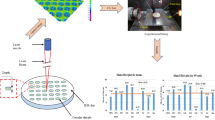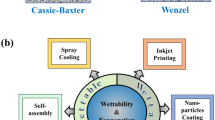Abstract
The pull-off forces between water and microstructured hydrophobic surfaces were calculated and measured in this study. A hydrophilically modified nickel disk was used to hold a drop of water. Regardless of the type of surface structure, as the solid fraction decreased, the pull-off force gradually decreased. Surfaces with pillar type structures had similar pull-off forces with different pillar sizes when the solid fractions were identical. This indicates that pillar size had no significant effect on the pull-off force. The pull-off force measured from the pore structures was higher than that measured from the pillar structures. As a result, the pillar-type microstructure provides a surface with a lower surface adhesive force than the pore type. The measurement technique used in this study allows the surface adhesive force to be quantified, making it very useful tool for evaluating the wettability of a solid surface.
Similar content being viewed by others
References
Meiron, T. S., Marmur, A., and Saguy, I. S., “Contact Angle Measurement on Rough Surfaces,” Journal of Colloid and Interface Science, Vol. 274, No. 2, pp. 637–644, 2004.
Rodrýguez-Valverde, M. A., Cabrerizo-Výlchez, M. A., Rosales-Lopez, P., Paez-Duenas, A., and Hidalgo-Alvarez, R., “Contact Angle Measurements on Two (Wood and Stone) Non-Ideal Surfaces,” Colloids and Surfaces A: Physicochemical and Engineering Aspects, Vol. 206, No. 1, pp. 485–495, 2002.
Adamson, A. W., “Physical Chemistry of Surfaces,” Wiley, 6th Ed., pp. 347–383, 1997.
Lin, S. Y., Chang, H. C., Lin, L. W., and Huang, P. Y., “Measurement of Dynamic/Advancing/Receding Contact Angle by Video Enhanced Sessile Drop Tensiometry,” Review of Scientific Instruments, Vol. 67, No. 8, pp. 2852–2858, 1996.
Bezuglyi, B. A., Tarasov, O. A., and Fedorets, A. A., “Modified Tilting-Plate Method for Measuring Contact Angles,” Colloid Journal, Vol. 63, No. 6, pp. 668–674, 2001.
Marmur, A., “Thermodynamic Aspects of Contact Angle Hysteresis,” Advances in Colloid and Interface Science, Vol. 50, pp. 121–141, 1994.
Decker, E. L. and Garoff, S., “Contact Angle Hysteresis: The Need for New Theoretical and Experimental Models,” The Journal of Adhesion, Vol. 63, No. 1–3, pp. 159–185, 1997.
Gouin, H., “The Wetting Problem of Fluids on Solid Surfaces. Part 2: The Contact Angle Hysteresis,” Continuum Mechanics and Thermodynamics, Vol. 15, No. 6, pp. 597–611, 2003.
Feng, L., Zhang, Y., **, J., Zhu, Y., Wang, N., et al., “Petal Effect: A Superhydrophobic State with High Adhesive Force,” Langmuir, Vol. 24, No. 8, pp. 4114–4119, 2008.
Bormashenko, E., Stein, T., Pogreb, R., and Aurbach, D., ““Petal Effect on Surfaces based on Lycopodium: High-Stick Surfaces Demonstrating High Apparent Contact Angles,” The Journal of Physical Chemistry C, Vol. 113, No. 14, pp. 5568–5572, 2009.
Torii, A., Sasaki, M., Hane, K., and Okuma, S., “Adhesion of Microstructures Investigated by Atomic Force Microscopy,” Sensors and Actuators A: Physical, Vol. 40, No. 1, pp. 71–76, 1994.
Bachmann, D., Kühne, S., and Hierold, C., “Determination of the Adhesion Energy of MEMS Structures by Applying Weibull-Type Distribution Function,” Sensors and Actuators A: Physical, Vol. 132, No. 1, pp. 407–414, 2006.
Cai, S. and Bhushan, B., “Meniscus and Viscous Forces during Separation of Hydrophilic and Hydrophobic Surfaces with Liquid-Mediated Contacts,” Materials Science and Engineering: R: Reports, Vol. 61, No. 1, pp. 78–106, 2008.
Cai, S. and Bhushan, B., “Meniscus and Viscous Forces during Normal Separation of Liquid-Mediated Contacts,” Nanotechnology, Vol. 18, No. 46, Paper No. 465704, 2007.
Cai, S. and Bhushan, B., “Meniscus and Viscous Forces during Separation of Hydrophilic And Hydrophobic Smooth/Rough Surfaces with Symmetric and Asymmetric Contact Angles,” Philosophical Transactions of the Royal Society A: Mathematical, Physical and Engineering Sciences, Vol. 366, No. 1870, pp. 1627–1647, 2008.
De Souza, E. J., Gao, L., McCarthy, T. J., Arzt, E. A., and Crosby, A. J., “Effect of Contact Angle Hysteresis on the Measurement of Capillary Forces,” Langmuir, Vol. 24, No. 4, pp. 1391–1396, 2008.
Butt, H. J. and Kappl, M., “Normal Capillary Forces,” Advances in Colloid and Interface Science, Vol. 146, No. 1, pp. 48–60, 2009.
Hager, W. H., “Wilfrid Noel Bond and the Bond Number,” Journal of Hydraulic Research, Vol. 50, No. 1, pp. 3–9, 2012.
De Gennes, P. G., Brochard-Wyart, F., and Quér, D., “Capillarity and Wetting Phenomena: Drops, Bubbles, Pearls, Waves,” Springer, pp. 118–119, 2004.
Berthier, J., “Micro-Drops and Digital Microfluidics,” William Andrew, 1st Ed., pp. 56–57, 2008.
Lee, S. M., Jung, I. D., and Ko, J. S., “The Effect of the Surface Wettability of Nanoprotrusions Formed on Network-Type Microstructures,” Journal of Micromechanics and Microengineering, Vol. 18, No. 12, pp. 125007, 2008.
Cassie, A. B. D. and Baxter, S., “Wettability of Porous Surfaces,” Transactions of the Faraday Society, Vol. 40, pp. 546–551, 1944.
Author information
Authors and Affiliations
Corresponding author
Rights and permissions
About this article
Cite this article
Lee, J.M., Lee, M.C., Lee, Sh. et al. Evaluation of surface wettability by means of the measurement of the adhesive force between a microstructured hydrophobic surface and a water droplet. Int. J. Precis. Eng. Manuf. 15, 2397–2404 (2014). https://doi.org/10.1007/s12541-014-0606-4
Received:
Revised:
Accepted:
Published:
Issue Date:
DOI: https://doi.org/10.1007/s12541-014-0606-4




